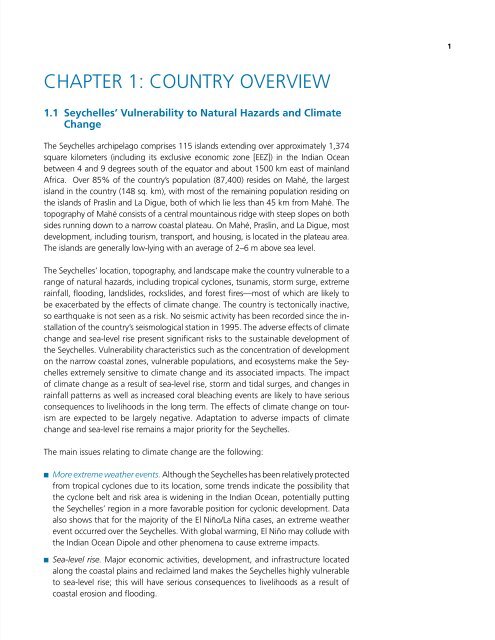Seychelles Damage, Loss, and Needs Assessment (DaLA ... - GFDRR
Seychelles Damage, Loss, and Needs Assessment (DaLA ... - GFDRR
Seychelles Damage, Loss, and Needs Assessment (DaLA ... - GFDRR
You also want an ePaper? Increase the reach of your titles
YUMPU automatically turns print PDFs into web optimized ePapers that Google loves.
1<br />
CHAPTER 1: Country Overview<br />
1.1 <strong>Seychelles</strong>’ Vulnerability to Natural Hazards <strong>and</strong> Climate<br />
Change<br />
The <strong>Seychelles</strong> archipelago comprises 115 isl<strong>and</strong>s extending over approximately 1,374<br />
square kilometers (including its exclusive economic zone [EEZ]) in the Indian Ocean<br />
between 4 <strong>and</strong> 9 degrees south of the equator <strong>and</strong> about 1500 km east of mainl<strong>and</strong><br />
Africa. Over 85% of the country’s population (87,400) resides on Mahé, the largest<br />
isl<strong>and</strong> in the country (148 sq. km), with most of the remaining population residing on<br />
the isl<strong>and</strong>s of Praslin <strong>and</strong> La Digue, both of which lie less than 45 km from Mahé. The<br />
topography of Mahé consists of a central mountainous ridge with steep slopes on both<br />
sides running down to a narrow coastal plateau. On Mahé, Praslin, <strong>and</strong> La Digue, most<br />
development, including tourism, transport, <strong>and</strong> housing, is located in the plateau area.<br />
The isl<strong>and</strong>s are generally low-lying with an average of 2–6 m above sea level.<br />
The <strong>Seychelles</strong>’ location, topography, <strong>and</strong> l<strong>and</strong>scape make the country vulnerable to a<br />
range of natural hazards, including tropical cyclones, tsunamis, storm surge, extreme<br />
rainfall, flooding, l<strong>and</strong>slides, rockslides, <strong>and</strong> forest fires—most of which are likely to<br />
be exacerbated by the effects of climate change. The country is tectonically inactive,<br />
so earthquake is not seen as a risk. No seismic activity has been recorded since the installation<br />
of the country’s seismological station in 1995. The adverse effects of climate<br />
change <strong>and</strong> sea-level rise present significant risks to the sustainable development of<br />
the <strong>Seychelles</strong>. Vulnerability characteristics such as the concentration of development<br />
on the narrow coastal zones, vulnerable populations, <strong>and</strong> ecosystems make the <strong>Seychelles</strong><br />
extremely sensitive to climate change <strong>and</strong> its associated impacts. The impact<br />
of climate change as a result of sea-level rise, storm <strong>and</strong> tidal surges, <strong>and</strong> changes in<br />
rainfall patterns as well as increased coral bleaching events are likely to have serious<br />
consequences to livelihoods in the long term. The effects of climate change on tourism<br />
are expected to be largely negative. Adaptation to adverse impacts of climate<br />
change <strong>and</strong> sea-level rise remains a major priority for the <strong>Seychelles</strong>.<br />
The main issues relating to climate change are the following:<br />
■■<br />
More extreme weather events. Although the <strong>Seychelles</strong> has been relatively protected<br />
from tropical cyclones due to its location, some trends indicate the possibility that<br />
the cyclone belt <strong>and</strong> risk area is widening in the Indian Ocean, potentially putting<br />
the <strong>Seychelles</strong>’ region in a more favorable position for cyclonic development. Data<br />
also shows that for the majority of the El Niño/La Niña cases, an extreme weather<br />
event occurred over the <strong>Seychelles</strong>. With global warming, El Niño may collude with<br />
the Indian Ocean Dipole <strong>and</strong> other phenomena to cause extreme impacts.<br />
■■<br />
Sea-level rise. Major economic activities, development, <strong>and</strong> infrastructure located<br />
along the coastal plains <strong>and</strong> reclaimed l<strong>and</strong> makes the <strong>Seychelles</strong> highly vulnerable<br />
to sea-level rise; this will have serious consequences to livelihoods as a result of<br />
coastal erosion <strong>and</strong> flooding.

















